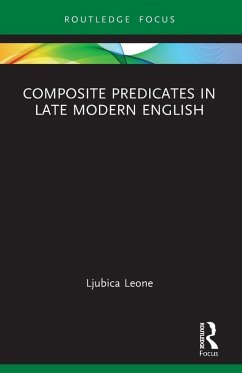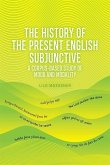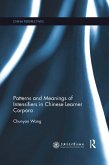Ljubica Leone
Composite Predicates in Late Modern English
Ljubica Leone
Composite Predicates in Late Modern English
- Broschiertes Buch
- Merkliste
- Auf die Merkliste
- Bewerten Bewerten
- Teilen
- Produkt teilen
- Produkterinnerung
- Produkterinnerung
This volume provides a concise overview of the diachronic development of composite predicates (CPs) in Late Modern English, offering clearer evidence of ongoing language change using data less readily available in other corpora.
Andere Kunden interessierten sich auch für
![Gramática española Gramática española]() Kim PotowskiGramática española52,99 €
Kim PotowskiGramática española52,99 €![The History of the Present English Subjunctive The History of the Present English Subjunctive]() Lilo MoessnerThe History of the Present English Subjunctive36,99 €
Lilo MoessnerThe History of the Present English Subjunctive36,99 €![Diachronic and Comparative Syntax Diachronic and Comparative Syntax]() Ian RobertsDiachronic and Comparative Syntax62,99 €
Ian RobertsDiachronic and Comparative Syntax62,99 €![Jin Chinese Grammar Jin Chinese Grammar]() Xing XiangdongJin Chinese Grammar110,99 €
Xing XiangdongJin Chinese Grammar110,99 €![The Power of Language The Power of Language]() Viorica MarianThe Power of Language9,99 €
Viorica MarianThe Power of Language9,99 €![Narrative Inquiry in Language Teaching and Learning Research Narrative Inquiry in Language Teaching and Learning Research]() Gary BarkhuizenNarrative Inquiry in Language Teaching and Learning Research60,99 €
Gary BarkhuizenNarrative Inquiry in Language Teaching and Learning Research60,99 €![Patterns and Meanings of Intensifiers in Chinese Learner Corpora Patterns and Meanings of Intensifiers in Chinese Learner Corpora]() Chunyan WangPatterns and Meanings of Intensifiers in Chinese Learner Corpora55,99 €
Chunyan WangPatterns and Meanings of Intensifiers in Chinese Learner Corpora55,99 €-
-
-
This volume provides a concise overview of the diachronic development of composite predicates (CPs) in Late Modern English, offering clearer evidence of ongoing language change using data less readily available in other corpora.
Produktdetails
- Produktdetails
- Verlag: Routledge
- Seitenzahl: 96
- Erscheinungstermin: 27. Oktober 2025
- Englisch
- Abmessung: 216mm x 140mm x 6mm
- Gewicht: 133g
- ISBN-13: 9781032530956
- ISBN-10: 1032530952
- Artikelnr.: 75428379
- Herstellerkennzeichnung
- Libri GmbH
- Europaallee 1
- 36244 Bad Hersfeld
- gpsr@libri.de
- Verlag: Routledge
- Seitenzahl: 96
- Erscheinungstermin: 27. Oktober 2025
- Englisch
- Abmessung: 216mm x 140mm x 6mm
- Gewicht: 133g
- ISBN-13: 9781032530956
- ISBN-10: 1032530952
- Artikelnr.: 75428379
- Herstellerkennzeichnung
- Libri GmbH
- Europaallee 1
- 36244 Bad Hersfeld
- gpsr@libri.de
Ljubica Leone is currently a postdoctoral fellow at the University of Milan, Italy. She received her PhD in Literary and Linguistic Studies from the University of Salerno, Italy.
List of figures
List of tables
Acknowledgments
List of abbreviations and conventions
Chapter 1. Composite predicates in 1750-1850
1.1. Background
1.2. Linguistic overview of composite predicates
1.3. Previous studies and research aims
1.4. The corpus: the Late Modern English-Old Bailey Corpus
1.4.1. Corpus compilation: source data, sampling, text types
1.4.2. Corpus architecture and size
1.5. Method: selectional criteria, corpus-based techniques, and statistical
tests
1.6. The structure of the book
Chapter 2. History
2.1. Old English and Middle English: the establishment of composite
predicates
2.2. Early Modern English: the spread of composite predicates
2.3. Late Modern English: stability and change
2.4. Present Day English: current forms and uses
Chapter 3. Linguistic Features
3.1. Distribution of composite predicates
3.2. The base verbs
3.3. Phrasal profile and productivity of composite predicates
3.3.1. Phraseological variation across the years 1750-1850
3.3.2. The use of deverbal nouns with more than one verb
3.3.3. Productivity
Chapter 4. Composite Predicates Between Stability and Change
4.1. Stable composite predicates
4.2. Morpho-syntactic features of composite predicate
4.2.1. Syntactic patterns
4.2.2. Articles and determiners
4.2.3. Internal modification
4.2.4. The use of plural forms
4.2.5. Passivization
4.3. Semantic features
Chapter 5. Processes of change
5.1. Grammaticalization and lexicalization
5.2. Phraseological variation and layering between alternative prepositions
5.3. The coinage of new composite predicates
5.4. Semantic change
Chapter 6. Conclusion
Appendix: list of composite predicates
References
Index
List of tables
Acknowledgments
List of abbreviations and conventions
Chapter 1. Composite predicates in 1750-1850
1.1. Background
1.2. Linguistic overview of composite predicates
1.3. Previous studies and research aims
1.4. The corpus: the Late Modern English-Old Bailey Corpus
1.4.1. Corpus compilation: source data, sampling, text types
1.4.2. Corpus architecture and size
1.5. Method: selectional criteria, corpus-based techniques, and statistical
tests
1.6. The structure of the book
Chapter 2. History
2.1. Old English and Middle English: the establishment of composite
predicates
2.2. Early Modern English: the spread of composite predicates
2.3. Late Modern English: stability and change
2.4. Present Day English: current forms and uses
Chapter 3. Linguistic Features
3.1. Distribution of composite predicates
3.2. The base verbs
3.3. Phrasal profile and productivity of composite predicates
3.3.1. Phraseological variation across the years 1750-1850
3.3.2. The use of deverbal nouns with more than one verb
3.3.3. Productivity
Chapter 4. Composite Predicates Between Stability and Change
4.1. Stable composite predicates
4.2. Morpho-syntactic features of composite predicate
4.2.1. Syntactic patterns
4.2.2. Articles and determiners
4.2.3. Internal modification
4.2.4. The use of plural forms
4.2.5. Passivization
4.3. Semantic features
Chapter 5. Processes of change
5.1. Grammaticalization and lexicalization
5.2. Phraseological variation and layering between alternative prepositions
5.3. The coinage of new composite predicates
5.4. Semantic change
Chapter 6. Conclusion
Appendix: list of composite predicates
References
Index
List of figures
List of tables
Acknowledgments
List of abbreviations and conventions
Chapter 1. Composite predicates in 1750-1850
1.1. Background
1.2. Linguistic overview of composite predicates
1.3. Previous studies and research aims
1.4. The corpus: the Late Modern English-Old Bailey Corpus
1.4.1. Corpus compilation: source data, sampling, text types
1.4.2. Corpus architecture and size
1.5. Method: selectional criteria, corpus-based techniques, and statistical tests
1.6. The structure of the book
Chapter 2. History
2.1. Old English and Middle English: the establishment of composite predicates
2.2. Early Modern English: the spread of composite predicates
2.3. Late Modern English: stability and change
2.4. Present Day English: current forms and uses
Chapter 3. Linguistic Features
3.1. Distribution of composite predicates
3.2. The base verbs
3.3. Phrasal profile and productivity of composite predicates
3.3.1. Phraseological variation across the years 1750-1850
3.3.2. The use of deverbal nouns with more than one verb
3.3.3. Productivity
Chapter 4. Composite Predicates Between Stability and Change
4.1. Stable composite predicates
4.2. Morpho-syntactic features of composite predicate
4.2.1. Syntactic patterns
4.2.2. Articles and determiners
4.2.3. Internal modification
4.2.4. The use of plural forms
4.2.5. Passivization
4.3. Semantic features
Chapter 5. Processes of change
5.1. Grammaticalization and lexicalization
5.2. Phraseological variation and layering between alternative prepositions
5.3. The coinage of new composite predicates
5.4. Semantic change
Chapter 6. Conclusion
Appendix: list of composite predicates
References
Index
List of tables
Acknowledgments
List of abbreviations and conventions
Chapter 1. Composite predicates in 1750-1850
1.1. Background
1.2. Linguistic overview of composite predicates
1.3. Previous studies and research aims
1.4. The corpus: the Late Modern English-Old Bailey Corpus
1.4.1. Corpus compilation: source data, sampling, text types
1.4.2. Corpus architecture and size
1.5. Method: selectional criteria, corpus-based techniques, and statistical tests
1.6. The structure of the book
Chapter 2. History
2.1. Old English and Middle English: the establishment of composite predicates
2.2. Early Modern English: the spread of composite predicates
2.3. Late Modern English: stability and change
2.4. Present Day English: current forms and uses
Chapter 3. Linguistic Features
3.1. Distribution of composite predicates
3.2. The base verbs
3.3. Phrasal profile and productivity of composite predicates
3.3.1. Phraseological variation across the years 1750-1850
3.3.2. The use of deverbal nouns with more than one verb
3.3.3. Productivity
Chapter 4. Composite Predicates Between Stability and Change
4.1. Stable composite predicates
4.2. Morpho-syntactic features of composite predicate
4.2.1. Syntactic patterns
4.2.2. Articles and determiners
4.2.3. Internal modification
4.2.4. The use of plural forms
4.2.5. Passivization
4.3. Semantic features
Chapter 5. Processes of change
5.1. Grammaticalization and lexicalization
5.2. Phraseological variation and layering between alternative prepositions
5.3. The coinage of new composite predicates
5.4. Semantic change
Chapter 6. Conclusion
Appendix: list of composite predicates
References
Index
List of figures
List of tables
Acknowledgments
List of abbreviations and conventions
Chapter 1. Composite predicates in 1750-1850
1.1. Background
1.2. Linguistic overview of composite predicates
1.3. Previous studies and research aims
1.4. The corpus: the Late Modern English-Old Bailey Corpus
1.4.1. Corpus compilation: source data, sampling, text types
1.4.2. Corpus architecture and size
1.5. Method: selectional criteria, corpus-based techniques, and statistical
tests
1.6. The structure of the book
Chapter 2. History
2.1. Old English and Middle English: the establishment of composite
predicates
2.2. Early Modern English: the spread of composite predicates
2.3. Late Modern English: stability and change
2.4. Present Day English: current forms and uses
Chapter 3. Linguistic Features
3.1. Distribution of composite predicates
3.2. The base verbs
3.3. Phrasal profile and productivity of composite predicates
3.3.1. Phraseological variation across the years 1750-1850
3.3.2. The use of deverbal nouns with more than one verb
3.3.3. Productivity
Chapter 4. Composite Predicates Between Stability and Change
4.1. Stable composite predicates
4.2. Morpho-syntactic features of composite predicate
4.2.1. Syntactic patterns
4.2.2. Articles and determiners
4.2.3. Internal modification
4.2.4. The use of plural forms
4.2.5. Passivization
4.3. Semantic features
Chapter 5. Processes of change
5.1. Grammaticalization and lexicalization
5.2. Phraseological variation and layering between alternative prepositions
5.3. The coinage of new composite predicates
5.4. Semantic change
Chapter 6. Conclusion
Appendix: list of composite predicates
References
Index
List of tables
Acknowledgments
List of abbreviations and conventions
Chapter 1. Composite predicates in 1750-1850
1.1. Background
1.2. Linguistic overview of composite predicates
1.3. Previous studies and research aims
1.4. The corpus: the Late Modern English-Old Bailey Corpus
1.4.1. Corpus compilation: source data, sampling, text types
1.4.2. Corpus architecture and size
1.5. Method: selectional criteria, corpus-based techniques, and statistical
tests
1.6. The structure of the book
Chapter 2. History
2.1. Old English and Middle English: the establishment of composite
predicates
2.2. Early Modern English: the spread of composite predicates
2.3. Late Modern English: stability and change
2.4. Present Day English: current forms and uses
Chapter 3. Linguistic Features
3.1. Distribution of composite predicates
3.2. The base verbs
3.3. Phrasal profile and productivity of composite predicates
3.3.1. Phraseological variation across the years 1750-1850
3.3.2. The use of deverbal nouns with more than one verb
3.3.3. Productivity
Chapter 4. Composite Predicates Between Stability and Change
4.1. Stable composite predicates
4.2. Morpho-syntactic features of composite predicate
4.2.1. Syntactic patterns
4.2.2. Articles and determiners
4.2.3. Internal modification
4.2.4. The use of plural forms
4.2.5. Passivization
4.3. Semantic features
Chapter 5. Processes of change
5.1. Grammaticalization and lexicalization
5.2. Phraseological variation and layering between alternative prepositions
5.3. The coinage of new composite predicates
5.4. Semantic change
Chapter 6. Conclusion
Appendix: list of composite predicates
References
Index
List of figures
List of tables
Acknowledgments
List of abbreviations and conventions
Chapter 1. Composite predicates in 1750-1850
1.1. Background
1.2. Linguistic overview of composite predicates
1.3. Previous studies and research aims
1.4. The corpus: the Late Modern English-Old Bailey Corpus
1.4.1. Corpus compilation: source data, sampling, text types
1.4.2. Corpus architecture and size
1.5. Method: selectional criteria, corpus-based techniques, and statistical tests
1.6. The structure of the book
Chapter 2. History
2.1. Old English and Middle English: the establishment of composite predicates
2.2. Early Modern English: the spread of composite predicates
2.3. Late Modern English: stability and change
2.4. Present Day English: current forms and uses
Chapter 3. Linguistic Features
3.1. Distribution of composite predicates
3.2. The base verbs
3.3. Phrasal profile and productivity of composite predicates
3.3.1. Phraseological variation across the years 1750-1850
3.3.2. The use of deverbal nouns with more than one verb
3.3.3. Productivity
Chapter 4. Composite Predicates Between Stability and Change
4.1. Stable composite predicates
4.2. Morpho-syntactic features of composite predicate
4.2.1. Syntactic patterns
4.2.2. Articles and determiners
4.2.3. Internal modification
4.2.4. The use of plural forms
4.2.5. Passivization
4.3. Semantic features
Chapter 5. Processes of change
5.1. Grammaticalization and lexicalization
5.2. Phraseological variation and layering between alternative prepositions
5.3. The coinage of new composite predicates
5.4. Semantic change
Chapter 6. Conclusion
Appendix: list of composite predicates
References
Index
List of tables
Acknowledgments
List of abbreviations and conventions
Chapter 1. Composite predicates in 1750-1850
1.1. Background
1.2. Linguistic overview of composite predicates
1.3. Previous studies and research aims
1.4. The corpus: the Late Modern English-Old Bailey Corpus
1.4.1. Corpus compilation: source data, sampling, text types
1.4.2. Corpus architecture and size
1.5. Method: selectional criteria, corpus-based techniques, and statistical tests
1.6. The structure of the book
Chapter 2. History
2.1. Old English and Middle English: the establishment of composite predicates
2.2. Early Modern English: the spread of composite predicates
2.3. Late Modern English: stability and change
2.4. Present Day English: current forms and uses
Chapter 3. Linguistic Features
3.1. Distribution of composite predicates
3.2. The base verbs
3.3. Phrasal profile and productivity of composite predicates
3.3.1. Phraseological variation across the years 1750-1850
3.3.2. The use of deverbal nouns with more than one verb
3.3.3. Productivity
Chapter 4. Composite Predicates Between Stability and Change
4.1. Stable composite predicates
4.2. Morpho-syntactic features of composite predicate
4.2.1. Syntactic patterns
4.2.2. Articles and determiners
4.2.3. Internal modification
4.2.4. The use of plural forms
4.2.5. Passivization
4.3. Semantic features
Chapter 5. Processes of change
5.1. Grammaticalization and lexicalization
5.2. Phraseological variation and layering between alternative prepositions
5.3. The coinage of new composite predicates
5.4. Semantic change
Chapter 6. Conclusion
Appendix: list of composite predicates
References
Index








